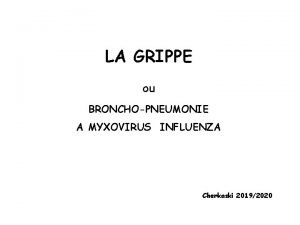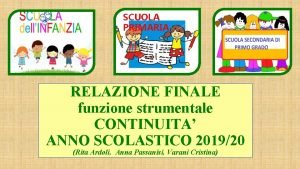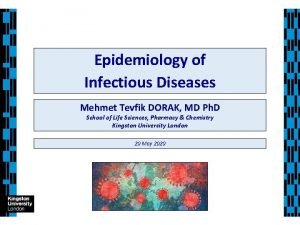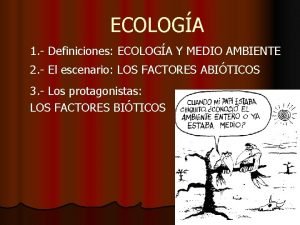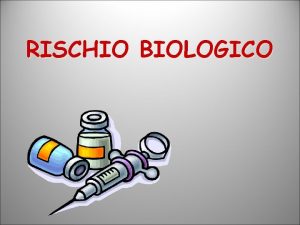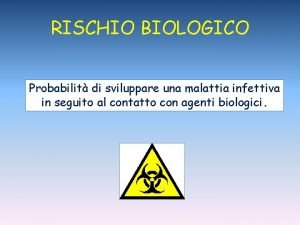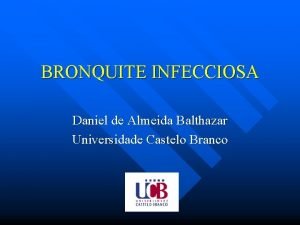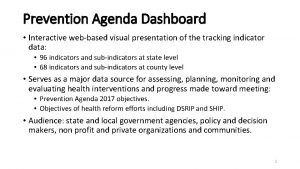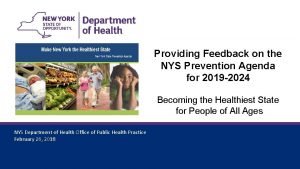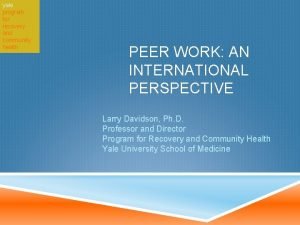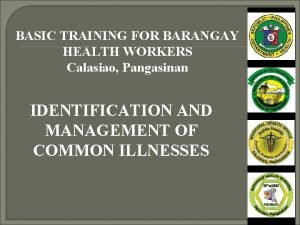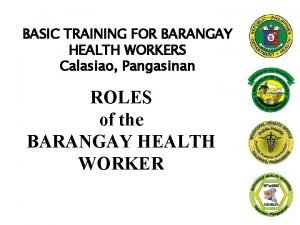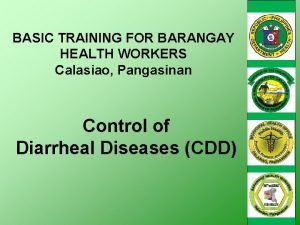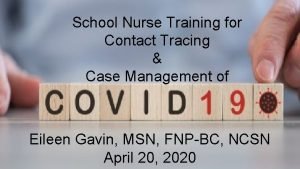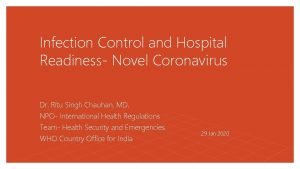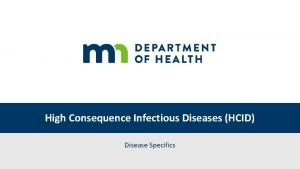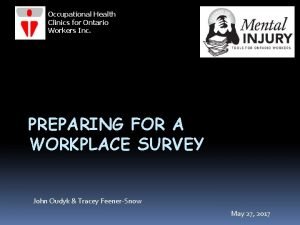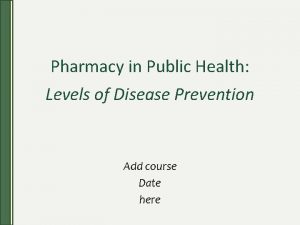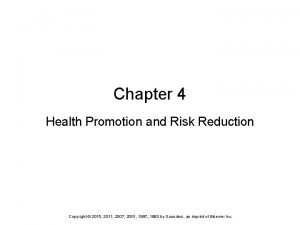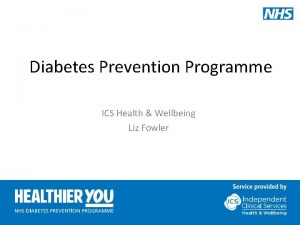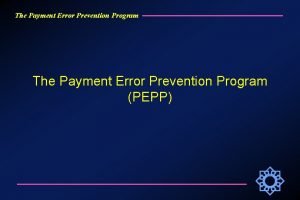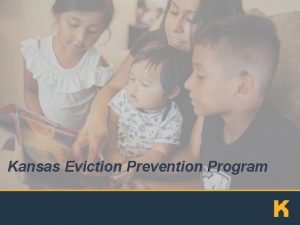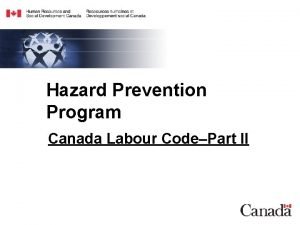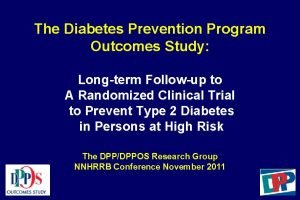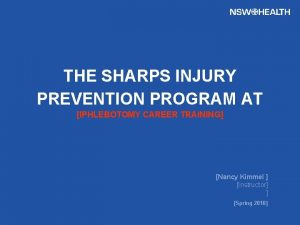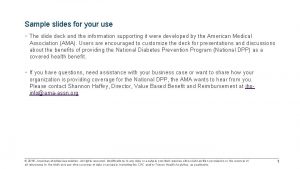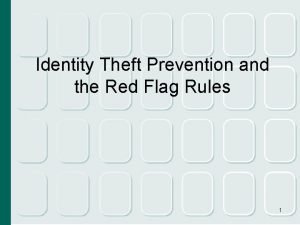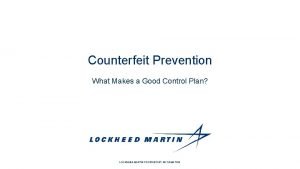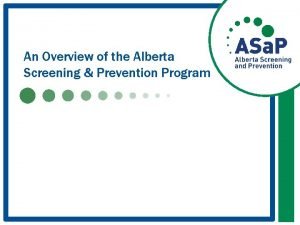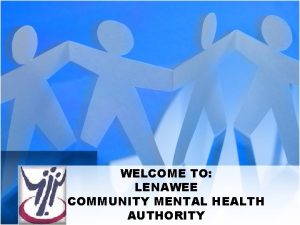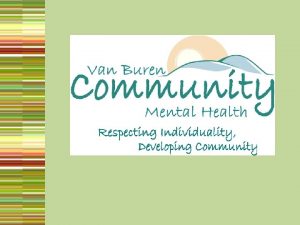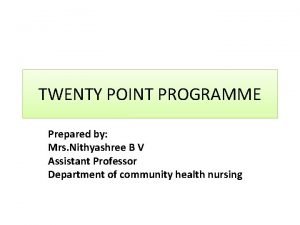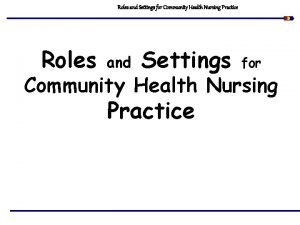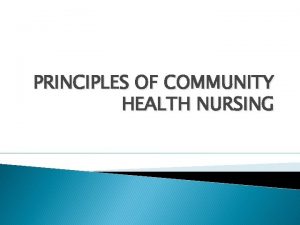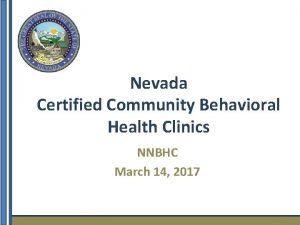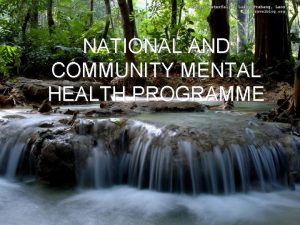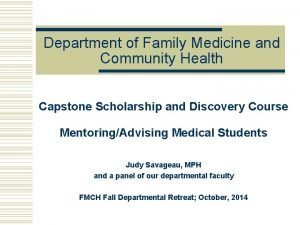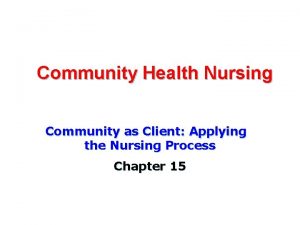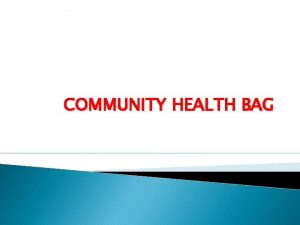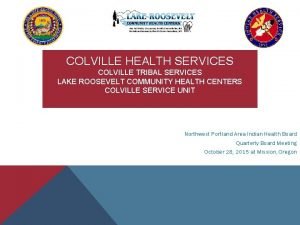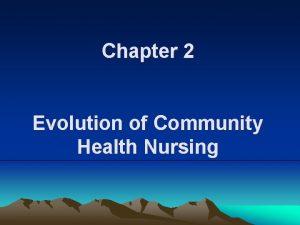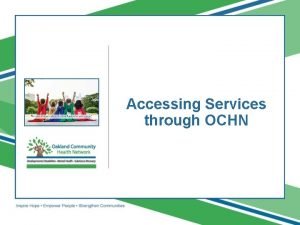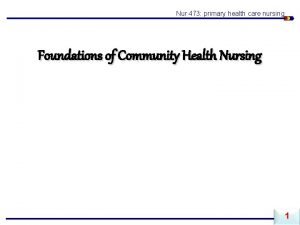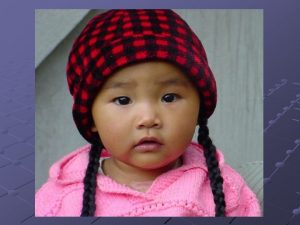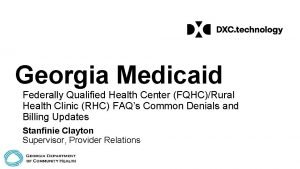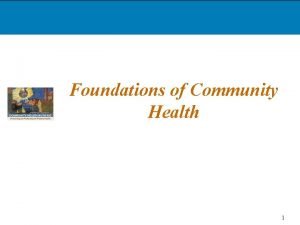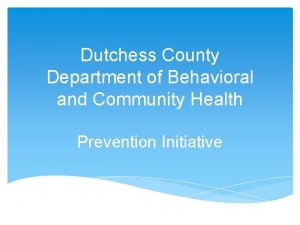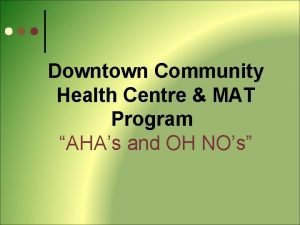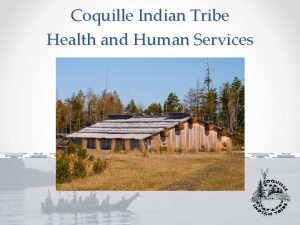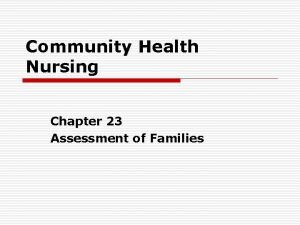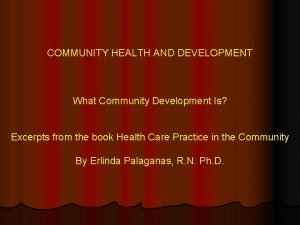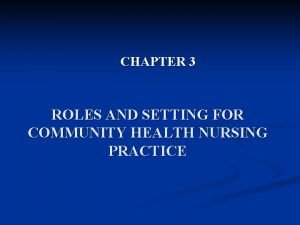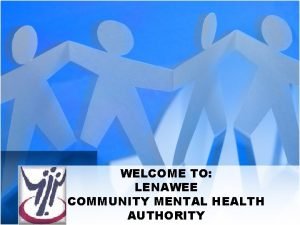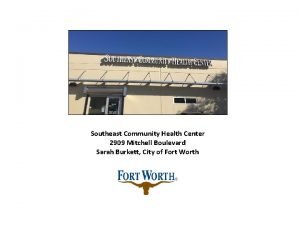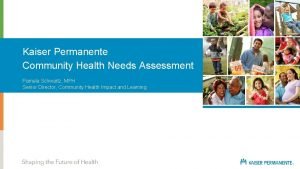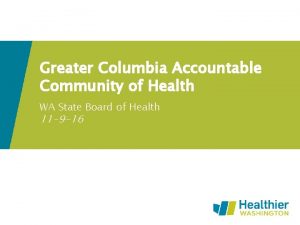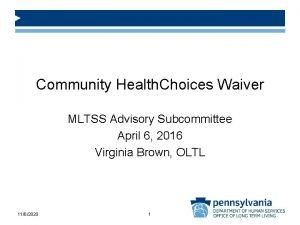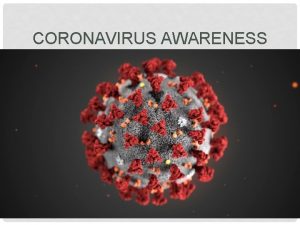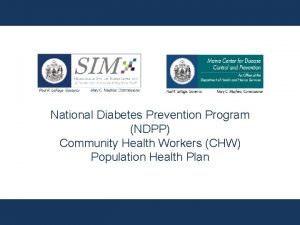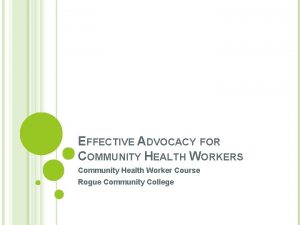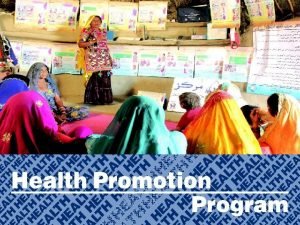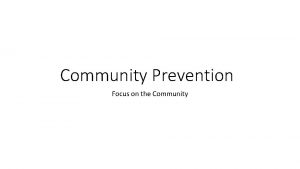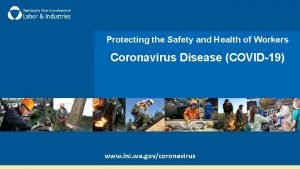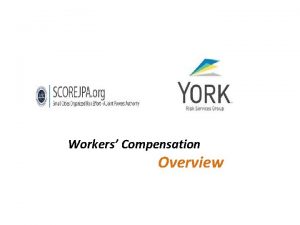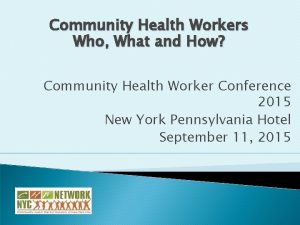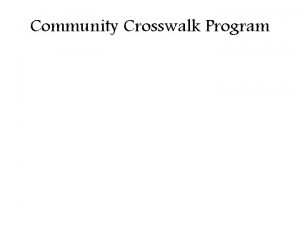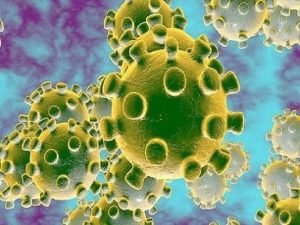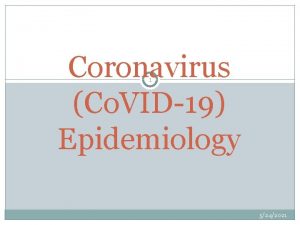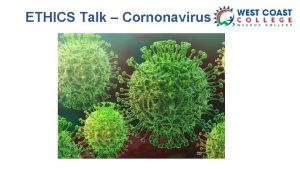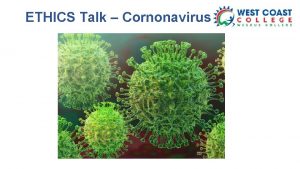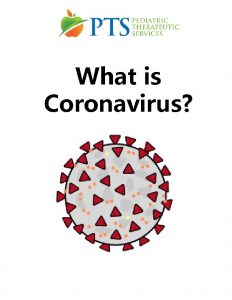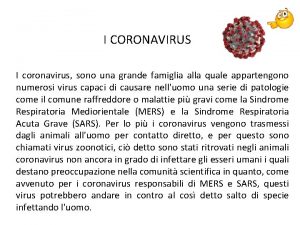Community Health Workers Coronavirus Prevention Program 1 Agenda









































































- Slides: 73

Community Health Workers Coronavirus Prevention Program 1

Agenda • What is COVID-19? • What are signs and symptoms of COVID-19? • Does COVID-19 affect us all the same? • How can I get COVID-19? • How can I prevent COVID-19? • What is my job as a Community Health Worker to prevent COVID-19? • Quiz & Group brainstorming 2

What is COVID-19? How do I know if I have it? 3

What is COVID-19? • COVID-19 is the short name for “coronavirus disease 2019. ” Coronavirus is a group of viruses. COVID-19 is the illness caused by coronavirus • COVID-19 is a new virus. Doctors and scientists are still learning about it • Recently, COVID-19 has caused many people to have a flu-like illness. Most of them recover fully, but some (including those of all age groups) become seriously ill and may not survive • Some people that don’t have symptoms can still spread the disease • Doctors and health experts are working hard to help people stay healthy 4

Coronavirus Statistics in Haiti 5

What are the common signs and symptoms of COVID-19? Fever (above 100. 4 F) COVID -19 99% of all cases!!! Cough Difficulty Breathing 59% of all cases!!! 31% of all cases!!! 6

What are other signs and symptoms of COVID-19? Fatigue (70%) Anorexia (40%) Muscle pain (35%) Coughing up thick phlegm from the lungs (27%) • Loss of smell • Sore throat • Headache • • • Chills Nausea or vomiting Diarrhea Coughing up blood Swollen eyes COVID-19 is caused by a type of virus that causes respiratory illness. This may lead to mucus and fluids in the airway of the lungs (pneumonia). 7

COVID-19 can look different in different people • For many people, having the coronavirus would be a little bit like having the flu causing mild symptoms (80% of cases) • Some people who have the virus don't have symptoms, but they can still spread the virus • A small group of people with other sicknesses may have more serious problems • Fluid build-up in the lungs, severe pneumonia • 3% die from the COVID-19 8

Who is most at risk for severe illness or death from COVID 19? • People 65 years old and older • People with serious medical conditions including diabetes • People with a weak immune system 9

Knowledge Check: • • • What is COVID-19? What are common symptoms? Does COVID-19 look the same in everyone? Who is most at risk? Do all people with coronavirus have symptoms? 10

How can I get COVID-19? 11

How can I get COVID-19? Breathing in droplets from an infected person's cough or sneeze. Touching something, like a table or a doorknob, that has been exposed to the virus (contaminated) and then touching your mouth, nose, or eyes. Droplets can stay infectious for about a week! 12

What increases my risk of getting COVID-19? • Come in contact with a sick person who recently traveled to an area with a COVID-19 outbreak • Provide care for or live with a person who is infected with COVID-19 • Note: that person may not show any symptoms • Live in or travel to an area with a COVID-19 outbreak • Not following the prevention tips! 13

Can I get COVID-19 from animals? • At this time, there is no evidence that the virus can spread to people from domestic animals • You should restrict contact with pets and other animals if you are sick with coronavirus until more information is known • At this time, no data to suggest that coronavirus is spread by mosquitoes • The main way that COVID-19 spreads is from person to person This is how the disease spreads! 14

How is COVID-19 diagnosed? A nasal swab or throat swab You need a test to know for sure! A physical exam Signs & symptoms 15

What is the treatment for COVID 19? There is still no treatment or vaccination for COVID-19. Prevention is KEY! 16

Knowledge Check: • What are ways that coronavirus is passed from one person to another person? • Can I get coronavirus from animals? • How do I know if I have COVID-19? • Is there a treatment or vaccination for COVID-19? • What is the best way to stop the spread of COVID-19? 17

How can I prevent COVID-19? 18

How can I prevent COVID-19? • Without a vaccine, the second-best way to end a viral pandemic is through containment • Keep space between you and other people • Stay home as much as possible (especially if you are sick) 19

How can I prevent COVID-19? • If you have to go out, keep 2 meters (or 6 feet) of space between yourself and others • This lowers the risk of the virus being passed to you by someone sneezing and coughing • Avoid crowds • If you go outside, follow the rules 20

How can I prevent COVID-19? • No handshaking or kisses to greet people • Nods, waves or bows are better • Try to use ONLY your knuckle to touch things in public areas • Open/close doors with your closed first or hip, do not grasp the handle (especially in the bathroom) • Cough or sneeze into a tissue or your elbow. If you use a tissue, throw it in the trash right away 21

How can I prevent COVID-19? • Do not touch your face (eyes, nose or mouth) • We touch our face 90 x/day without knowing it! • Cover your mouth and nose • The mask will not prevent the virus in a direct sneeze, but will prevent you from touching your nose and mouth 22

How can I prevent COVID-19? • Coronavirus can last for several hours on various types of surfaces • Cardboard: up to 24 hours • Plastic or stainless steel: 2 to 3 days • Other materials: up to a week • Clean and disinfect. • You can clean first with soap and water, but disinfect surfaces you touch often, like tables, doorknobs, light switches, toilets, faucets, and sinks • Use a mix of household bleach and water- Disinfect with Bleach if available. 1: 100 has shown to kill the virus 23

How can I prevent COVID-19? • Wash your hands! • Especially after blowing your nose, coughing, or sneezing; going to the bathroom; before eating or preparing food; and after touching items • Wash your hands with soap and water for at least 20 seconds. You can sing the alphabet song • If you don’t have soap and water, use a hand sanitizer that contains at least 60% alcohol 24

Handwashing Steps • https: //www. youtube. com/watch? v=se. A 1 wb. X UQTs 25

Hand Sanitizer Recipe What you’ll need: • 3/4 cup of isopropyl or rubbing alcohol (99 percent) • 1/4 cup of aloe vera gel (to help keep your hands smooth and to counteract the harshness of alcohol) • 10 drops of essential oil, such as lavender oil, or you can use lemon juice instead Directions: • Pour all ingredients into a bowl, ideally one with a pouring spout like a glass measuring container • Mix with a spoon and then beat with a whisk to turn the sanitizer into a gel • Pour the ingredients into an empty bottle for easy use, and label it “hand sanitizer” 26

How to make a Tippy-Tap 27

Knowledge Check: • Why is it important to “social distance” (not come close to other people)? • What are five things you can teach your neighbors to prevent the spread of COVID 19? • Who can show us the proper way to wash our hands? 28

Nutrition Tips 29

Recommended food plate HYDRATE with clean water - At least two liters a day! 30

Protein • Inexpensive, shelf stable plant proteins: legumes, nuts, seeds • More expensive and not shelf stable animal proteins: meat, fish, eggs, dairy • Both are groups are equally great sources of protein • Necessary for the immune system and growth and maintenance of body tissues 31

Fruits & Vegetables • Provide vitamins, minerals, and fiber necessary for health • Provide fiber needed for proper digestive health 32

Starches • Grains, grain products (bread, pasta, cereal), and some starchy vegetables (like potatoes, sweet potatoes, & corn) • Provide energy, fiber, and vitamins and minerals 33

Balanced and Not Balanced Plates Healthier version boiled and baked foods, with protein, starches, and vegetables (above) Fried and less balanced (no vegetables) (left) 34

Things you don’t need, especially if money is tight • Sugar, coffee, tea, soda, sports drinks (the only necessary beverage is clean water) • Candy, sweets, pastries • Processed foods like hot dogs, instant noodles, & chips • Oil, margarine, butter (though these are helpful if you are trying to gain weight) 35

Knowledge Check: • • What does a healthy meal include? What is the best drink choice? How much water should you drink? If your budget is tight, what are foods you should eliminate? 36

Supporting patients through COVID-19: psychosocial and mental health considerations 37

The COVID-19 outbreak has had an impact on our mental health and emotions. Patients and providers alike may be experiencing symptoms of stress, anxiety and worry around contracting the virus and due to the effects the outbreak has had on everyday life. 3 8

COVID-19: Effects on patient psychosocial functioning Patients who have tested positive for COVID-19 may be experiencing feelings such as: ▪ Shame and/or stigma of having the virus: it is important to avoid referring to patients who test positive with COVID-19 as strictly “the COVID patient” or “victims”. Their identity should not be defined by the virus, to reduce stigma ▪ Being in survival mode: worries about being unable to work or meet basic needs like food, medications and housing ▪ Loss of control: people are being recommended to quarantine or practice social distancing, however some must continue working to survive. This may lead to feeling conflicted between caring for themselves and their families and meeting basic needs 3 9

COVID-19: Effects on patient psychosocial functioning Additionally: ▪ Feelings of Grief/Loss: grieving loss of everyday life prior to the outbreak, or grief around confirmation of having COVID-19 or knowing someone else who does ▪ Fear of our their own mortality: hearing about COVID-related deaths can trigger feelings of worry and anxiety for patients, especially those who have tested positive for COVID-19 ▪ New or exacerbated Health Anxiety: experiencing stress and worry around contracting or testing positive for the virus. High stress levels can impact mood, sleep and appetite 4 0

COVID-19: Assess psychosocial functioning As healthcare workers, we can best support our patients by assessing how they are coping with COVID-19 and offering practical solutions Assess for: ▪ ▪ Current symptoms of depression and/or anxiety Changes to their mood, sleep, or appetite Coping skills: adaptive or maladaptive Impacted access to basic needs 4 1

COVID-19: Explore patients coping skills If patients express experiencing symptoms of grief, anxiety or depression, help them explore their coping skills: ▪ What do they like to do to relax? Music, writing and prayer can be very therapeutic ▪ Who do they enjoy talking to when they are going through a tough time? Now is the best time to lean on their support system ▪ How are they staying connected despite being quarantined/social distancing? Social media makes staying connected easier than ever ▪ How are they practicing self-care at this time? Eating healthy, practicing good hygiene, taking all their medications, resting and getting good sleep is so important. All of these help give a sense of control 4 2

COVID-19: Assess for natural supports If referrals for resources are not available in your area, assess for patients natural support system: ▪ Who do they consider supportive and trustworthy in their lives? ▪ Is there a friend, family member, or neighbor who can help them by sharing food, money, transportation? ▪ Be solution-focused: has the patient ever been in crisis before? What or who helped them cope or get their needs met? ▪ Explore their spirituality: What is their belief system and how can this be used to cope through this time? Are there people they can turn to from their religious community? 4 3

Additional recommendations: Psychoeducation Encourage Mindfulness Practices: ▪ Focus on being present and in the moment: Repeating calming statements such as “In this moment, I am OK” or closing their eyes and counting slowly to 10 ▪ Encourage visualization of a person or place that bring them comfort and joy: “Think of your favorite day and tell me about it. Who were you with, where were you, what was your favorite part about it? ” ▪ Prompt the patient to think of 2 or 3 things they are grateful for: “Who or what are you grateful for today? ” ▪ Remind them that they can access these things anywhere and anytime. 4 4

Additional recommendations: Psychoeducation Teach patients about challenging negative or worrisome thoughts: ▪ ▪ ▪ Cognitive Triangle Thoughts: Everything starts with how we think. Behaviors: When we start to believe our thoughts, it can change our behavior which affects our feelings. Feelings: When we let our negative thoughts affect our behavior, our feelings of fear, anxiety and lack of control are reinforced and the cycle continues. 4 5

Additional recommendations : Psychoeducation Cognitive Triangle: Break the Cycle Negative thought: “I tested positive for COVID-19 and now no one will want to be around me. ” This thought can lead to stress, hopelessness, and emotional isolation New, positive thought: “I can’t control that I am sick, but I can focus on reaching out for support in ways that keep me and others safe. I have people who care about me and want to be here for me” New behavior: Staying present and shifting focus onto what they can control, like taking good care of themselves and/or using creative ways to stay connected to their support system while in isolation. ( via phone, social media, family practicing good hygiene when coming in contact) Feeling afterward: Comforted, supported and in control 4 6

Final Considerations We can help curb the effects on mental health and psychosocial functioning that our patients may experience due to COVID-19 by encouraging them to: • • • Stay safe and practice good hygiene Lean on natural supports Maintain connections while isolating Practice relaxation techniques Limit news and social media intake Challenge scary or negative thoughts By helping our patients cope, we can promote hope and send ripple effects of resiliency into our communities 4 7

Knowledge Check: • How might a person feel who is infected with the coronavirus? • What are some coping skills? • How can you change a negative thought into positive thoughts and behaviors? 48

My Role as a Community Health Worker 49

Role of Community Health Workers • You are the FIRST line of defense for stopping the corona virus • Protection is key while there is no cure • You can identify suspected cases • You can raise awareness and educate households for prevention in the community and in families 50

How can you identify an infected patient? • Is there a new cough, fever, sore throat, fatigue, or shortness of breath? • Is the temperature over 100. 4 F? 38. 0 C? • Has the person been in any infected areas or near someone who has been in any infected areas in the last 14 days? 51

What should I tell someone if I think he/she has COVID-19? • Isolate immediately • Avoid sharing personal items such as phones, computers and work areas • Clean and disinfect frequently touched objects and surfaces (this should always be done frequently) • Ventilate your home whenever possible • Make certain both you as well as all people in your family are wearing masks and following all prevention recommendations 52

What do I do if I think someone has COVID-19? • If a person does get sick, it doesn’t mean they have COVID -19 • If a person suspects having COVID-19, they can contact you or a doctor to share their symptoms/duration of symptoms. You should then contact a doctor to let them know about the patient’s symptoms. If the doctor determines that the person needs to go in to the clinic they should wear a mask and gloves to not infect others. Goal is to prevent the spread, so not all patients should go to the doctor • After testing (if testing available), the patients should stay home and away from others until told different 53

Recommendations for families if someone is suspected to have COVID-19? • If the person has to interact, they should wash their hands first • Clean anything they touched, then they should go back to isolation • Even caretakers should have no sustained physical contact, keep distance, keep hands clean • The vast majority of people are going to have a fever, body aches and feel horrible for 3 -5 days, and better by 7 • You can interact when your fever is gone but should continue to wear a mask and wash your hands! 54

Tips for Community Health Workers when working in your community • Be calm and accurate • Don’t make up facts and it’s okay not to know. We are still learning everyday about this • Be empathetic. This topic can cause a lot of fear. It’s okay to feel worried • Remind them that doctors around the world are working to find solutions and care for people who are already sick 55

Safety of Community Health Workers • Wear a mask when talking to community members • Wash your hands between every house visit • If you think someone may be infected, make sure the person and their family members wear masks • Whether you think they are infected or not, wipe down all equipment after every use (stethoscope, BP cuff and machine, pens, pencils, and binders) • Don’t touch your eyes, nose or mouth • Don’t use your mouth to open packages or hold your pens 56

Knowledge Check: • What is your role in your community to prevent COVID-19? • What should you do if you think someone has COVID-19? • How can you keep yourself safe? 57

Brainstorming Activities 58

Brainstorm Session: How can you raise awareness in your community members without coming in close contact with people? 59

Brainstorm Session: How can you promote correct and frequent handwashing in your community? 60

Brainstorm Session: How can you keep a protective distance from people 6 feet apart? How can you teach children that this is important? 61

Brainstorm Session: How can you promote staying at home in your community? 62

COVID-19 Quiz 1. What is COVID-19/coronavirus? 2. What are the symptoms of COVID-19? 3. How does COVID-19 spread? 4. How can I protect myself from the disease? 5. Who is at-risk of developing a severe illness? 6. Is there medicine or a vaccination for COVID-19? 7. Should I wear a mask? 8. Can I get COVID-19 from my pets? 9. How long does the virus survive on surfaces? 10. Can coronavirus be airborne? 63

Handmade Masks 64

Do Fabric Face Masks Work? Yes and no. They're not as effective as N 95 masks, but they're still useful because hospitals are completely running out of masks altogether. The CDC advises using N 95 masks for the best protection, but it says to use a bandana or scarf as a last resort if no surgical masks are available. Unfortunately we're at that point in this pandemic, so homemade masks are being made to replace bandanas and scarves. 65

Option 1: Easy - no sewing required 66

Option # 1: Needed materials: Cotton fabric or cotton bandana 2 hair ties Fold a square fabric into a rectangle Insert the hair ties to each side Bring the end sides to the middle and secure in the middle Pull the hair ties and loop in behind the ears 67

Option 2: Sewing required 68

Option # 2: What fabric to choose: The best fabric for homemade masks is a tightly woven, 100% cotton fabric. Things like denim, bed sheets, and heavyweight shirts are all good options. Avoid knit fabrics (e. g. jersey T-shirts) because they create holes when they stretch, which the virus could get through. Make sure to prewash fabrics using hot water to kill germs 69

Print this pattern: 70

Step by Step Instruction: 1. 2. 3. 4. 5. 6. 7. 8. 9. 10. 11. 12. 13. 14. 15. 16. 17. 18. 19. Cut pattern out Use pattern to cut 2 cotton fabric pieces Use pattern to cut 2 interfacing pieces (MUST be nonwoven) Place cut fabric with front sides together Place both layers of the interfacing together on top of fabric (on the back side of fabric) Sew top 9” seam (2. 5 -3 stitch length is best) with ¼” seam allowance Flip open with front side of fabric up Press seam flat to one side Insert metal piece along seam between the 2 pieces of fabric Stitch ½” rectangle that is indicated at top of pattern (with wrong sides together) to secure metal piece Flip back to right sides together, stitch bottom 9” seam Flip back to right side out and press bottom seam Use pattern to help mark pleats. Pleat the 3 pleats all in the same direction, put a pin to keep them in place Cut binding tape at 36” per side Find the center point of the binding and the center point of the mask and pin the binding on the mask with the mask sandwiched between the binding Sew binding Repeat on the other side of the mask Press pleats Finally, pat yourself on the back, because you are making a difference! 71

Questions? 72

Resources: • World Health Organization The World Health Organization (WHO) is a specialized agency of the United Nations responsible for international public health. WHO works worldwide to promote health, keep the world safe, and serve the vulnerable. WHO is on the forefront of global health emergencies, breakthroughs, and communication, making them one of the most trustworthy resources during the COVID-19 outbreak. • • WHO COVID-19 Resource Page • WHO Rolling Event Summary • WHO Live Map Center for Disease Control and Prevention The Center for Disease Control and Prevention is a public health institute of the United States. Headquartered in Atlanta, Georgia, the CDC works diligently to protect America from both foreign and in the U. S. from health threats. Information from the CDC is an incredibly valuable resource, especially during this pandemic. • CDC Website • COVID 19 Latest Updates • CDC Coronavirus Disease 2019 (COVID-19) Situation Summary 73
 Primary prevention secondary prevention tertiary prevention
Primary prevention secondary prevention tertiary prevention Natalia agapitova
Natalia agapitova Scissurite coronavirus
Scissurite coronavirus Relazione finale classe seconda primaria
Relazione finale classe seconda primaria Coronavirus
Coronavirus Factores intraespecíficos
Factores intraespecíficos Segnale di rischio biologico
Segnale di rischio biologico Contenitori per trasporto materiale biologico
Contenitori per trasporto materiale biologico Bronquite coronavirus
Bronquite coronavirus Prevention agenda dashboard
Prevention agenda dashboard Nys prevention agenda
Nys prevention agenda Agenda sistemica y agenda institucional
Agenda sistemica y agenda institucional Roles of occupational health nurse
Roles of occupational health nurse Larry davidson yale
Larry davidson yale Paano nakakahawa ang leptospirosis
Paano nakakahawa ang leptospirosis Basic training for barangay health workers
Basic training for barangay health workers Basic training for barangay health workers
Basic training for barangay health workers Basic training for barangay health workers
Basic training for barangay health workers C.d.c. covid isolation health workers
C.d.c. covid isolation health workers Covid isolation health workers
Covid isolation health workers C.d.c. covid isolation health workers
C.d.c. covid isolation health workers Covid isolation health workers
Covid isolation health workers Career skills in health informatics chapter 2
Career skills in health informatics chapter 2 Occupational health clinics for ontario workers purpose
Occupational health clinics for ontario workers purpose National programme for maternal and child
National programme for maternal and child Health promotion and levels of disease prevention
Health promotion and levels of disease prevention Health promotion and levels of disease prevention
Health promotion and levels of disease prevention Diabetes wellness programme
Diabetes wellness programme Payment error prevention program
Payment error prevention program Kshousingcorp/eviction-prevention-program
Kshousingcorp/eviction-prevention-program Hazard prevention program
Hazard prevention program Diabetes prevention program outcomes study
Diabetes prevention program outcomes study Sharps injury prevention program
Sharps injury prevention program Diabetes prevention program ppt
Diabetes prevention program ppt Identity theft prevention program
Identity theft prevention program Counterfeit parts prevention program as5553
Counterfeit parts prevention program as5553 Alberta screening and prevention program
Alberta screening and prevention program Plan together in community mobilization
Plan together in community mobilization Lenawee county cmh
Lenawee county cmh Van buren cmh
Van buren cmh Twenty point programme was launched in the year
Twenty point programme was launched in the year Nursing diagnosis three parts
Nursing diagnosis three parts Collaborative interventions nursing
Collaborative interventions nursing Role and functions of community health nurse
Role and functions of community health nurse Principles of chn
Principles of chn Collaborative nursing interventions
Collaborative nursing interventions Psych nursing care plan examples
Psych nursing care plan examples Ccbhc nevada
Ccbhc nevada Objectives of community mental health
Objectives of community mental health Family and community health advisor
Family and community health advisor Shuster and goeppinger community diagnosis
Shuster and goeppinger community diagnosis What is community bag
What is community bag Colville community health center
Colville community health center Development of community health nursing
Development of community health nursing Evolution of community health nursing
Evolution of community health nursing Ochn customer service
Ochn customer service Home visit assignment
Home visit assignment Elements of community health nursing
Elements of community health nursing Define home visit
Define home visit Community health evangelism
Community health evangelism Georgia department of community health
Georgia department of community health Characteristics of community health nursing
Characteristics of community health nursing Dutchess county mental hygiene
Dutchess county mental hygiene Downtown community health clinic
Downtown community health clinic Coquille indian tribe community health center
Coquille indian tribe community health center Family care plan in community health nursing
Family care plan in community health nursing Importance of community health
Importance of community health Role of community health
Role of community health Lenawee community mental health
Lenawee community mental health Southeast community health center
Southeast community health center Pamela schwartz kaiser
Pamela schwartz kaiser Greater columbia accountable community of health
Greater columbia accountable community of health Community health status indicators
Community health status indicators Community health choices waiver
Community health choices waiver


